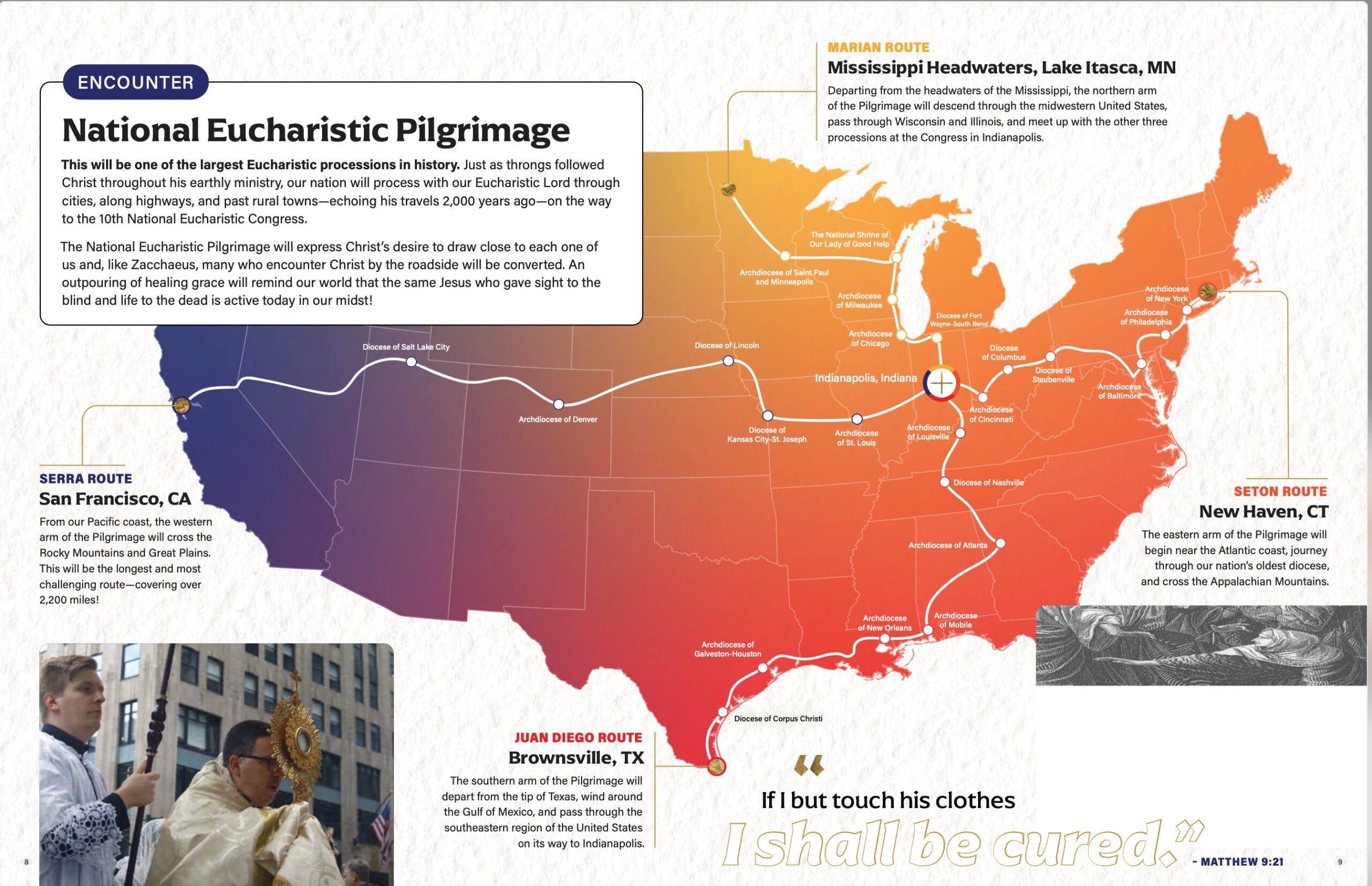
PROSPECT HEIGHTS — A year from now, 48 Catholics spread out at four separate locations across the country will embark on a two-month pilgrimage to Indianapolis for the start of the National Eucharistic Congress. If everything goes according to plan, they’ll encounter more than 100,000 Catholics along the way.
The National Eucharistic Congress has announced the routes and plans for the National Eucharistic Pilgrimage that will begin next Pentecost Sunday, May 19, 2024, and conclude in Indianapolis, the site of the National Eucharistic Congress, on July 16, 2024. The four pilgrimage routes, each taking off from a different region of the U.S., will cover approximately 6,500 miles, and run through 65 dioceses.
The pilgrimage is a next step in the U.S. bishops’ three-year National Eucharistic Revival initiative.
“It is a stirring vision — Christ truly present in the Eucharist, traveling across our nation inviting crowds of hungry souls to come and be fed,” Will Peterson, president and founder of Modern Catholic Pilgrim said in a statement. “The pilgrimage is modeled after the road to Emmaus and is an invitation for pilgrims to encounter the risen Christ on the journey and in the breaking of the bread before being missioned back into their local communities to spread the fire.”
Modern Catholic Pilgrim is a nonprofit organization that organizes walking pilgrimages nationwide. It partnered with the National Eucharistic Congress to plan the National Eucharistic Pilgrimage.
The four cities the pilgrimage will start from are: San Francisco; Bemidji, Minnesota; New Haven, Connecticut; and Brownsville, Texas. Each route was named for saintly significance corresponding to the geographical starting point. San Francisco is the Serra Route, after St. Junípero Serra. Bemidji is the Marian Route, after the veneration of Mary. New Haven is the Seton Route, after St. Elizabeth Seton. And Brownsville is the Juan Diego Route, after St. Juan Diego.
Formal plans for each route are still in the works.
What’s been revealed at this point is the intention for the San Francisco route to begin with a eucharistic procession across the Golden Gate Bridge. Plans are also in the works for a procession down the Hudson River in New York, with the intention of stopping at Ellis Island to “honor the faith brought to the United States,” according to the National Eucharistic Congress. There are plans for a Mass adoration and crawfish boil down along the Gulf Coast, as well.
Each route will have 12 “perpetual pilgrims” — young adult Catholics between the ages of 19-29 — who will lead the way, along with priest chaplains who will cycle through on a weekly schedule. However, the National Eucharistic Congress has made it clear that these pilgrims will not walk the entire journey. There will be a support vehicle “for legs of the journey in which safety, terrain, and/or climate may present obstacles,” according to the NEC. Pilgrims will travel 10-15 miles a day, and be offered stays at parishioner homes and diocesan-related centers.
An application process for those interested to be one of the 48 “perpetual pilgrims” will open this summer, followed by an interview process in the fall.
The priest chaplains will be charged with helping celebrate Mass, lead the eucharisitc procession, take part in devotions, and hear confessions. In general, there will be a consistent schedule for each pilgrimage route that includes Mass and major solemn procession on Sundays, with Mass and smaller processions at parishes during the week.
There will also be day pilgrims, who are the 100,000-plus Catholics expected to join the pilgrimage along the way on what will be designated official segments. Peterson said they will make sure to give all Catholics an opportunity to participate, even if not directly on the road.
“People cannot wait to join the route near them, and for those who cannot join a route, we will have free resources for making their own eucharistic pilgrimages starting this summer so that all Catholics in the U.S. can participate,” Peterson said.
Part of the impetus for the U.S. bishops launching the National Eucharistic Revival initiative in 2021 was a 2019 Pew study that showed just 30% of Catholics understand the real presence of Christ in the Eucharist. The first year was focused on the diocesan level, with the second year focused on the parish level. The pilgrimage and subsequent National Eucharistic Congress in Indianapolis — with an expected attendance of 80,000 — are the culmination of the initiative.
Bishop Andrew Cozzens, the U.S. Conference of Catholic Bishops’ Evangelization and Catechesis Committee chair, who has spearheaded the National Eucharistic Revival initiative, has said the goal is to “create a movement of Catholics across the United States, healed, converted, formed, and unified by an encounter with Jesus in the Eucharist — and sent out in mission ‘for the life of the world.’”
